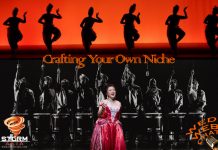Walk down any street in Havana and you will find an eclectic assortment of building architecture.
From neoclassical to art deco styles, the buildings are emblematic of not only the varied and lush culture of Cuba, but also of the country’s tumultuous past. What has come of it is perhaps one of the most beautiful things about Cuba that I encountered in my time there — a certain attitude and appreciation of “Vida libre” (Live freely).
It is on these streets — surrounded by pink, turquoise, yellow and completely dilapidated buildings — that you find music, dancing, and art being lived, created and enjoyed.
Arriving on a Monday afternoon, I took a short walk through one of the main squares of Havana — “Habana Vieja” (Old Havana) — to familiarise myself with the neighbourhood. Within minutes, I was approached by several locals who spouted on about a salsa festival at Rosalia De Castro, a somewhat rundown, grey building which from the outside would be easily missed, and yet on the inside had looming high ceilings and a contagious warm vibe about it.
Featuring members of the renowned Buena Vista Social Club, Havana on a Monday night did not leave me wanting – and is quintessentially Cuban in the way that no matter the day or the time, the celebration of life and art is not only saved for or confined to the week’s end.
While places like Rosalia De Castro in Habana Vieja is somewhat of a tourist trap, venture around the square and walk the many winding roads that branch off its centre to find more local digs where the art, culture and its people will not disappoint.
Along Calle O’Reilly (O’Reilly Street), you will find the open gallery of visual artist, Leo D’Lazaro. Also known as Ojo de Cyclone (Eye of the Hurricane), the name is befitting of the space with a smorgasbord of eccentric pairings between sculpture, recycled materials and personal memorabilia.
As you walk in, you see Leo’s old car, now painted and rusting parked in the centre of the two-storey space. Walk further in and you will find floating heads on iron carcasses and unexpected tributes to the Beatles and more. I happened to chance upon his gallery on a Sunday afternoon and whilst roaming around Leo invited me to return in a few hours for a night of community Tango dancing there.
Havana’s Colourful Locales
It was this recurring integration of dance, life and art that I began to encounter all throughout my stay in Havana that sparked my further interest and appreciation of its people and their culture.
One of the most fascinating streets I found in Havana was Callejón de Hamel. Located outside of Habana Vieja, this small street of psychedelically coloured wall murals houses not only one of Havana’s local artist communities, but more intriguingly is the main hub for the country’s Santería followers.
Santería is an Afro-Cuban religion that originated from the country’s history of African slavery and to this day, still exists with a certain degree of preeminence. Chance upon women dressed completely in white or someone who sports yellow and green beaded necklaces or bracelets as you roam the streets and it’s more than likely that they are of this religion. (Do not attempt to take their photos though as this is against their religion).
Upon entering Callejón de Hamel you are immediately surrounded and engulfed by wall murals, sculptures, and old bathtubs made into benches. I was invited to walk through the hole-in-the-wall galleries, most famously that of the artist in residence there — Salvador. His presence is evident from his quotes lining the entrance of the space, and the local residents of this street speak fondly of him. As I enter his gallery, it is dark and damp and with my phone’s light I illuminate paintings and sculptures of the different orishas (deities) of Santería.
Cross to the other side and you find a bar with Salvador’s abode above it. Even within the bar you find interesting Santería artworks and tributes, and it makes for a nice pit stop to have a drink and soak in the vibe of this unique neighbourhood.
Beyond the rich spirit and artwork of the space, visit on a Sunday afternoon and you will find a thriving Rumba party made up of locals dancing the day away.
Outside Plaza de la Catedral in Habana Vieja you will find two older women dressed in white sitting at tables just at the edge of the square, and for CUC 5 (SG $6.70) you can partake in your first Santería ritual.
Smoking a formidably fat cigar is Johanna de Cuba. Sit next to her and she will begin to chant and sing for peace and good health as she raises a glass of water to the sky. Handing you a deck of cards, you will be required to pick 21 of them and lay them out — from which she will begin to read your future and give you advice for good health and fortune.
Most of her advice is tied to Santería, such as dressing in all white from time to time, cleansing yourself with a specific number of fruit by the ocean and much more. Believe what she tells you or not, it was by far one of the most interesting experiences I had in Cuba.
If you’re looking for something a little more commercial or modern, venture to one of Havana’s popular night spots — Fábrica de Arte Cubano (otherwise known as FAC). A large factory warehouse that has been turned into a gallery space, a night club and a concert hall all rolled into one, you can go there most nights of the week and find interesting visual art installations, dance demonstrations and lessons, a pop concert, a fashion show and even some art film showings littered throughout the building’s many floors.
While all of this dancing and rhythmic living scattered throughout the lively Havana may not be for everyone, it’s definitely still worth experiencing first hand. For those who don’t dance like myself, just another amazing thing about Cuba is how uninhibited and carefree its people are.
As one of the many locals I met in my short time there told me: “It doesn’t matter if you don’t know how to dance. If you’re moving, you’re dancing.”

There are regular flights to Havana from Spain, France and Italy.



















